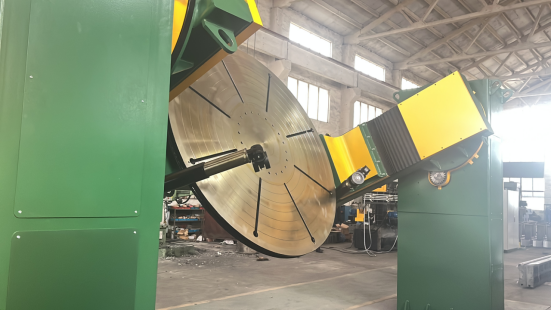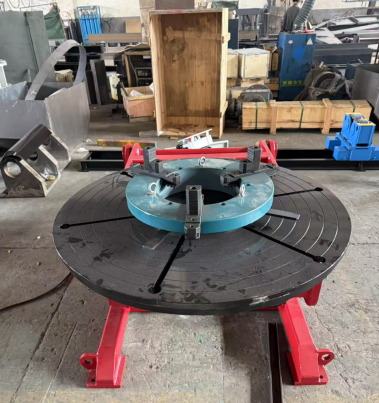Technological Breakthrough in Welding Position Control
Modern welding positioners utilize advanced servo control systems to achieve angular positioning accuracy of 0.05 degrees. This technological breakthrough eliminates the limitations of manual position adjustments in traditional welding. Equipped with high-precision encoders and closed-loop control algorithms, the system monitors and adjusts rotation in real time, ensuring the welding torch always maintains the optimal working angle.

Dynamic Load Compensation Technology
To meet the welding demands of heavy pressure vessels, next-generation positioners feature intelligent dynamic load compensation systems. By monitoring motor torque and load variations in real time, the system automatically adjusts control parameters to maintain stable rotation speed even when the workpiece’s center of gravity shifts during welding. One model demonstrates speed fluctuations within ±0.5% when handling 30-ton workpieces.
Core Technologies for Welding Process Optimization
Precise Heat Input Control
The synchronized control system between the welding positioner and power source enables dynamic parameter matching. By adjusting rotation speed in real time to coordinate with variations in welding current and voltage, it ensures consistent heat input per unit length of the weld. Test data show this method reduces heat input fluctuations from ±20% in manual welding to just ±3%.
Multi-Axis Coordinated Motion Control
High-end welding positioners employ multi-axis synchronization technology, allowing rotation to be coordinated with the transverse movement of the welding torch. This synchronized motion is particularly suitable for spiral welds, enabling continuous, uninterrupted welding. One model achieves a repeatable trajectory accuracy of ±0.1mm when welding 3-meter-diameter vessels.
Innovations in Equipment Structural Design
Modular Frame Structure
Modern welding positioners adopt a modular design philosophy, with the main frame constructed from high-strength alloy steel and critical load-bearing areas optimized through finite element analysis. This design ensures structural integrity while allowing easy configuration adjustments for different workpiece sizes. One manufacturer offers standard models covering load capacities from 1 to 50 tons.

Intelligent Safety Protection System
The equipment integrates multiple safety measures, including overload protection, emergency braking, and abnormal vibration monitoring. A machine learning-based predictive maintenance system can identify potential failures in advance, reducing unplanned downtime by over 80%. All safety-critical components comply with SIL2 safety standards.
Advantages of Digital Integration
Weld Data Traceability System
The built-in data acquisition module records all key parameters during welding, including rotation speed, current, and voltage. This data is transmitted in real time via industrial Ethernet to the MES system, providing complete traceability for quality assurance. One project demonstrated that this feature reduced quality traceability time from 48 hours to just 2 hours.
Remote Monitoring & Diagnostics
With 4G/5G connectivity, the equipment supports remote status monitoring and fault diagnosis. Service technicians can access real-time operational data to detect potential issues early. One user reported a 60% reduction in on-site service requests thanks to this feature.
Energy Efficiency Optimization Technologies
Regenerative Braking Energy Recovery
Advanced drive systems employ regenerative braking to convert kinetic energy into electricity during deceleration, feeding it back into the grid. Actual measurements show this technology reduces energy consumption by 15–20%. For continuous production lines, annual energy savings can reach tens of thousands of kilowatt-hours.
Intelligent Standby Management System
When idle, the system automatically enters low-power mode while maintaining essential monitoring functions. Optimized power management reduces standby consumption to less than 5% of rated power, significantly lowering operating costs.
Future Technological Developments
AI-Assisted Process Optimization
Next-generation welding positioners are integrating AI algorithms to analyze historical welding data and automatically optimize process parameters. Tests indicate this system can reduce process debugging time by 70% while improving weld consistency.
Digital Twin Applications
By creating a digital twin of the equipment, welding processes can be simulated and optimized in a virtual environment. This technology is particularly valuable for complex workpiece welding development, reducing trial-and-error costs in production. One case study showed a 40% reduction in new product development cycles using digital twins.
